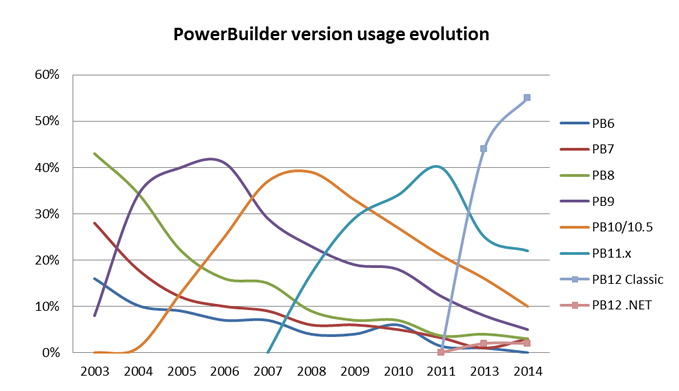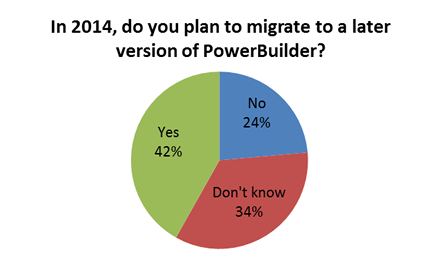What do the current PowerBuilder Projects look like?
Which versions of PowerBuilder are currently used?

Other PB versions used
| Version | % |
| PB12 Classic | 17% |
| PB11 | 13% |
| PB10 | 10% |
| PB9 | 10% |
| PB12.NET | 8% |
| PB7 | 6% |
| PB8 | 3% |
PowerBuilder 12 Classic remains the most used version, with an 11% increase as more respondents migrated towards this version in 2014.
We can see that PB.Net is seldom used as a main development tool (only 2% of the respondents). It is more frequently used for secondary developments, probably due to .NET interoperability (producing or consuming .NET components). C.f. question 6 for more details.

Over time, we see PB 11 confirm the typical life cycle of PowerBuilder versions: a rise during 3 or 4 years, and then a progressive decline and a long term usage that stretches over more than a decade.
We can see that PowerBuilder 7 applications are still found in production today (they are more numerous than PB.NET!)
PowerBuilder 12 is still in the growth phase. Given that PB 12.6 is considered a major release of PowerBuilder, in the 2015 PowerBuilder survey we will separate it from PB 12 and we’ll be able to see the speed of adoption of the latest version of PowerBuilder released by SAP.
We will also be able to see if the PB12 curve reverses at the same speed as the other versions of PowerBuilder (PB 12 will have been around for more than 3 years). The wait between the last 2 releases will most likely prolong the life of the previous version.


There’s an increase in the number of developers looking to migrate to a new version of PB. This number had been decreasing from 2011 – 2013. With the release of PowerBuilder 12.6, more people are interested in migrating to a new version, representing a 5% increase in ‘Yes’ and a 9% decrease in ‘No’.
This evolution is probably caused by 2 factors:
- The release of PB15/PB 12.6 took longer than usual; therefore, it’s normal that a larger number of projects have been expecting it and will use it soon.
- This version is compatible with recent environments (Windows 8, the latest Database versions etc.). Numerous projects have to evolve to these recent environments, and a migration that would support them should be planned for next year.
